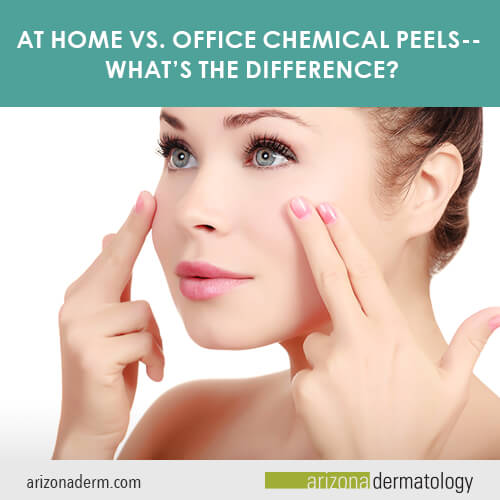 Chemical peels are a great way to keep your skin healthy and youthful in appearance. They can improve the look of a number of skin issues, including hyperpigmentation, fine lines and wrinkles, as well as sun damage. Peels can also treat some forms of acne and give the skin a brighter, more radiant look.
Chemical peels are a great way to keep your skin healthy and youthful in appearance. They can improve the look of a number of skin issues, including hyperpigmentation, fine lines and wrinkles, as well as sun damage. Peels can also treat some forms of acne and give the skin a brighter, more radiant look.
How do chemical peels work?
An acidic chemical solution is applied to the skin to remove the top layers, exposing the younger, healthier skin layers beneath. Chemical peels fall into three categories: superficial, medium and deep.
But what exactly is the difference between a chemical peel you can do at home and one you get at the dermatologist’s office? Here is a breakdown of what you get with a home chemical peel versus one done by a professional.
Superficial chemical peels
Over-the-counter peels that you can do at home are generally superficial, thus not as effective as medium or deep peels. That said, one should never try to self- administer a “medium” or “deep peel”. The chemicals used in store bought peels are generally low concentrations of mild acids such as an alpha hydroxy acid or salicylic acid . Store bought superficial peels can sometimes be effective in minimizing the appearance of mild acne, blackheads and whiteheads. They can also help skin appear more hydrated and supple. Superficial peels should not be painful. They may cause some tingling, but don’t have any downtime associated with them.
Medium chemical peels
Medium peels involve higher concentrations of chemicals that work on deeper layers of the skin. A medium peel will remove the layers of the epidermis and actually reach into the upper layers of the dermis as well. This can be an effective treatment for acne, blackheads, whiteheads, moderate sun damage, age spots, fine lines and wrinkles, hyperpigmentation or discoloration, and light acne scarring. Medium peels may also be recommended for precancerous growths (i.e. actinic keratosis).
Safety First
Medium peels should only be done in a dermatologist’s office. They contain a higher concentration of acid (for example, 50% TCA or up to 70% Jessner’s solution and 35% TCA). During the first 48 hours after the peel, expect your skin to appear pink or even red in color. During the downtime period (1 to 2 weeks), you can expect your skin to crust and peel off. Your doctor will give you antibacterial solutions and ointments to ensure full healing. Depending on your desired results, your doctor may recommend a medium peel every three to nine months.
Deep chemical peels
These peels are the strongest chemical peels available. They not only remove the epidermis, but also some of the mid to lower dermis. A deep chemical peel can be used to treat scars, moderate to severe sun damage, deep wrinkles and precancerous growths.
A deep chemical peel is not something that should be performed outside of a doctor’s office. Patients should know that deep peels can be quite painful, thus your doctor may offer sedation and/or a local anesthetic during the treatment. Phenol chemical peels are the strongest peels available. They must be applied to the entire face, never used as “spot treatments.” After a deep chemical peel you can expect quite a bit of swelling and a recovery period of two to three weeks (sometimes more) during which time you will experience redness and a crusting and peeling off of the skin. Your doctor will give you aftercare instructions to ensure proper healing.
Not everyone is a good candidate for chemical peels. They can be dangerous for people with certain medical conditions. They also do not work well for those with darker skin tones or people with freckles (deep peels will eliminate freckles). However, if your doctor recommends a deep chemical peel, you can expect drastic results from a single treatment. Deep peels are not repeated at intervals like superficial or medium peels.
If you are considering a chemical peel, consider booking a consultation with one of our providers to discuss the benefits of the many forms of cosmetic dermatology offered at our offices.


